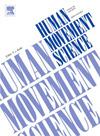在直步和转步中选择交替脚位的基础
IF 1.9
3区 心理学
Q4 NEUROSCIENCES
引用次数: 0
摘要
在复杂的地形上行走时,人类通常会提前多步规划脚的放置策略。提前计划步骤对直立稳定性和向前进步都是有益的,但一个缺点是新的障碍会使计划好的脚放置位置在计划和执行之间变得不安全,需要快速转移到脚放置位置,从而影响稳定性和进步。本研究探讨了直立和转身步态中交替足部放置的选择。13名健康的年轻人沿着一条虚拟投影的人行道行走,这些人行道的精确立足点可以是一条直线,也可以是一个60°、90°或120°的单步或向右旋转。步转是指身体在外侧肢体接触地面时的旋转,而自旋是指身体在内侧肢体上的旋转。在一部分试验中,参与者被要求迅速避免踩在选定的立足点上。分层自举分析揭示了跨步转和自旋转不同转角的刻板交替足部放置策略。具体来说,当他们识别到一个新的障碍物时,无论转弯角度如何,交替的脚位置都与人的接近轨迹保持一致;然而,交替的脚位置打乱旋转转身与人的未来转弯轨迹对齐。我们的结论是,当人类被迫快速改变先前发展的足部运动计划时,他们利用快速的刻板行为,根据转弯的需要改变。本文章由计算机程序翻译,如有差异,请以英文原文为准。
Bases for the selection of alternate foot placement during straight- and turning-gait
Humans typically plan foot placement strategy multiple steps in advance when walking across complex terrain. Planning steps in advance is beneficial for both upright stability and forward progress, but one drawback is that new obstacles can make planned foot placement location unsafe between planning and execution, necessitating a rapid shift to foot placement that impacts both stability and progress. This study investigates the selection of alternate foot placement during both straight- and turning-gait. Thirteen healthy young adults walked along a virtually projected walkway with precision footholds oriented in either a straight line or with a single 60°, 90°, or 120° step or spin turn to the right. Step turns are turns where the rotation of the body occurs while the outside limb is in contact with the ground, whereas spin turns pivot over the inside limb. On a subset of trials, participants were required to rapidly avoid stepping on select footholds. Hierarchical bootstrapping analyses revealed stereotyped alternate foot placement strategies across turn angles that differed between step turns and spin turns. Specifically, alternate foot placement for step turns aligned with the person's approach trajectory when they identified a new obstacle, regardless of turn angle; whereas alternate foot placement for disrupted spin turns aligned with the person's future turn trajectory. We conclude that when humans are forced to rapidly alter previously developed motor plans for foot placement, they utilize a rapid stereotyped behavior that changes based on the demand of the turn.
求助全文
通过发布文献求助,成功后即可免费获取论文全文。
去求助
来源期刊

Human Movement Science
医学-神经科学
CiteScore
3.80
自引率
4.80%
发文量
89
审稿时长
42 days
期刊介绍:
Human Movement Science provides a medium for publishing disciplinary and multidisciplinary studies on human movement. It brings together psychological, biomechanical and neurophysiological research on the control, organization and learning of human movement, including the perceptual support of movement. The overarching goal of the journal is to publish articles that help advance theoretical understanding of the control and organization of human movement, as well as changes therein as a function of development, learning and rehabilitation. The nature of the research reported may vary from fundamental theoretical or empirical studies to more applied studies in the fields of, for example, sport, dance and rehabilitation with the proviso that all studies have a distinct theoretical bearing. Also, reviews and meta-studies advancing the understanding of human movement are welcome.
These aims and scope imply that purely descriptive studies are not acceptable, while methodological articles are only acceptable if the methodology in question opens up new vistas in understanding the control and organization of human movement. The same holds for articles on exercise physiology, which in general are not supported, unless they speak to the control and organization of human movement. In general, it is required that the theoretical message of articles published in Human Movement Science is, to a certain extent, innovative and not dismissible as just "more of the same."
 求助内容:
求助内容: 应助结果提醒方式:
应助结果提醒方式:


